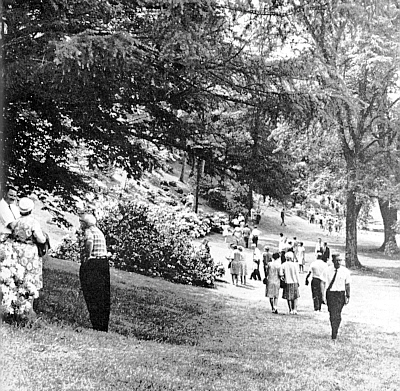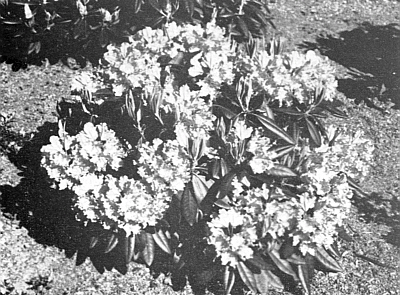QBARS - v24n3 Testing and Breeding Rhododendrons in Nova Scotia
Testing and Breeding Rhododendrons in Nova Scotia
D. L. Craig
Canada Department of Agriculture
Research Station, Kentville, Nova Scotia

|
|
Fig. 47. Rhododendron Sunday at the Canada Department
of Agriculture Research Station, Kentville, Nova Scotia. |
The Kentville Research Station located in the heart of the beautiful Annapolis Valley, consists of 400 acres of land and is devoted to horticultural research. According to the plant hardiness classification of Ouellet and Sherk (1) it is in plant zone 6a. A cursory glance at the map will show that 43.50 north latitude runs through the western tip of Nova Scotia and into the U. S. near Portland, Maine. The province is virtually surrounded by the Atlantic Ocean and for this reason we enjoy winters that are much milder than those found further inland. The relatively mild winters make it possible to grow rhododendrons and azaleas.
An average snowfall of 82 inches is part of the 40.8 inches of moisture that we receive each year. We enjoy 126 frost free days each year and our warmest months are July and August with average daily maximums of 77.4 and 75.9° F respectively. January and February are our coldest months.

|
|
Fig. 48. A Kentville Research Station selection from
'Dr. H. C. Dresselhuys' x R. smirnowii . |
| Table 1 shows the percentage of years with minimum temperatures as low or lower than those indicated (2). | ||
| Percent or years | ||
| Temperature | January | February |
| -25 | 0 | 0 |
| -20 | 9 | 7 |
| -15 | 22 | 15 |
| -10 | 38 | 38 |
| - 5 | 67 | 71 |
| 0 | 91 | 87 |
| 5 | 98 | 98 |
| 10 | 100 | 100 |
Many gardens in Nova Scotia have a rhododendron or two and perhaps a few azaleas. A few gardens and public parks have rather extensive plantings but they are made up entirely of catawbiense hybrids and azaleas such as japonicum or the Ghents. Thus there is an obvious need for improvement.
Cultivar Testing
Species and cultivar testing began at Kentville in 1952. Seed and plants were obtained from botanical gardens. private gardens, nurseries and research stations from all over North America and Europe. We have a natural setting with a large area near a pond for ornamental plantings.
At the present time, our plantings contain 57 species and 111 cultivars. Each year we discard a number of species and cultivars because of lack of hardiness and each year we add a number of new ones. We have learned that we can grow any plant with a hardiness rating of H1 and virtually all those rated H2. Plants rated H3 have flowered at Kentville but they are unreliable.
The succession of bloom begins on May 15 with mucronulatum and then continues with lapponicum , degronianum , impeditum , russatum , schlippenbachii , racemosum , vaseyi , roseum , carolinianum , fastigiatum , japonicum , luteum , catawbiense compactum , catawbiense album Glass, calendulaceum , bakeri and finally maximum on July 10.
Our Knaphill azaleas put on a fine show in mid June at which time our 'ironclads' and other rhododendron hybrids are also in full bloom. Many of our species and cultivars are just reaching the flowering stage or have only flowered once or twice so we are quite uncertain of their reliability.
Breeding for Nova Scotia
Because we are well beyond the accepted range where the more desirable rhododendrons can thrive, we decided in 1959 to carry on a breeding program to produce rhododendrons better adapted to our region. Our principal objective is to produce hardy, compact rhododendrons to extend the flowering season and like many other breeders to produce rhododendrons with good yellow flowers.
We are not breeding azaleas because we believe it would be difficult to improve upon species such as japonicum , calendulaceum , schlippenbachii and vaseyi and the Ghent, Mollis and Knaphill cultivars.
Our first crosses involved R. smirnowii , R. catawbiense var. album 'Glass' and 'Dr. Dresselhuys'. The 800 seedlings from these crosses were grown to flowering stage in the field where they were completely exposed. From these, we made a number of selections. All are very hardy, rather compact and pink flowered (FIG. 48).
Since making these first crosses the author has had an opportunity to see many rhododendrons on the east and west coast of America. England and Scotland. The author spent a year (1963-64) in Scotland so had an excellent opportunity to visit the Royal Botanical Garden in Edinburgh and numerous private gardens and estates. These visits plus the opportunity to observe the performance of the many new cultivars now maturing at the Kentville Station has raised our sights considerably.
Since 1958, we have made 158 crosses using such species and cultivars as fortunei , williamsianum , degronianum , yakushimanum , fastigiatum , carolinianum , 'Carmen', 'Impi', 'Elizabeth', 'Goldsworth Yellow', 'Cunningham's White' and others. Many of the primary hybrids from crosses made in the early 60's have now been selfed or sibbed. We have many second generation seedlings in our greenhouses, lath house and nursery beds. We anticipate that many of these will prove of value as selections for introduction or for further crossing. While we wait on these seedlings and plan more crosses we look forward to June when the Research Station has a Rhododendron Sunday. Our objective of showing to the public the great range and beauty of the rhododendron is being reached. We are excited about the untapped potential of this genus for gardens in Nova Scotia.
REFERENCES
1. Ouellet, C. E., Sherk, L. C., Map of plant hardiness zones in Canada. Canada Department of
Agriculture Publication, 1967.
2. Summary of Weather Records, Canada Department of Agriculture Publication 1092, 1961.
